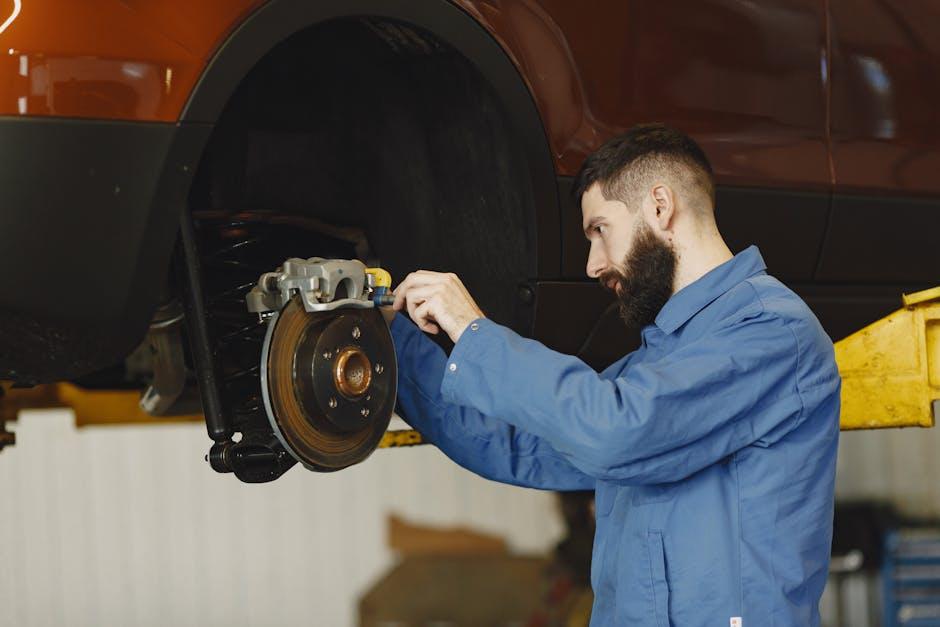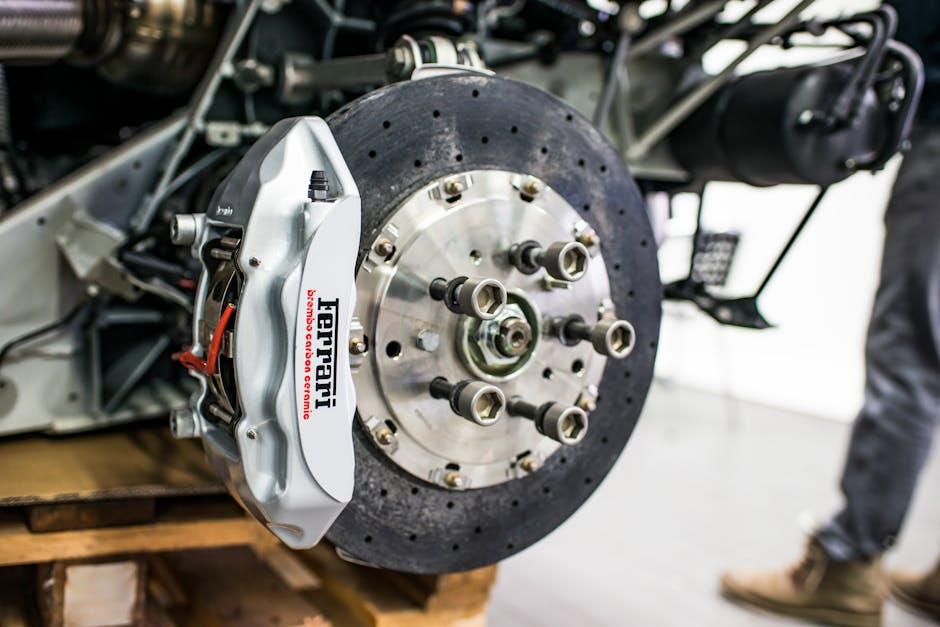When it comes to stopping power, not all brake pads are created equal. As drivers seek the perfect balance between performance, comfort, and longevity, the choice often narrows down to two popular contenders: ceramic and metallic brake pads. Each type brings its own unique blend of strengths and trade-offs, shaping the driving experience in subtle yet significant ways. In this article, we’ll explore the benefits of ceramic versus metallic brake pads, helping you make an informed decision the next time your vehicle calls for a brake upgrade. Whether you prioritize quiet rides, durability, or heat resistance, understanding these materials can steer you toward the right fit for your wheels—and the road ahead.
Table of Contents
- Understanding Material Composition and Performance Differences
- Impact on Vehicle Noise and Vibration Levels
- Heat Dissipation and Brake Fade Resistance Explained
- Wear Patterns and Longevity in Varied Driving Conditions
- Environmental Considerations and Eco-Friendly Choices
- Choosing the Right Brake Pads for Your Driving Style and Budget
- Q&A
- In Summary

Understanding Material Composition and Performance Differences
When diving into the differences between ceramic and metallic brake pads, it’s essential to understand the core materials that define their performance. Ceramic brake pads are crafted from dense ceramic fibers, nonferrous filler materials, and bonding agents. This composition yields a product that operates quietly, produces minimal brake dust, and excels in maintaining consistent stopping power across a range of temperatures. On the other hand, metallic brake pads are primarily constructed using a blend of steel, copper, iron, and other metals, resulting in a robust pad that excels under high-stress conditions, particularly in demanding braking scenarios.
Each material responds differently to wear and heat, which plays a critical role in their functionality and longevity. Below is a quick comparison to highlight these distinctions:
| Aspect | Ceramic Brake Pads | Metallic Brake Pads |
|---|---|---|
| Noise Level | Quiet operation | Can be noisy |
| Heat Dissipation | Moderate | Excellent |
| Brake Dust | Low dust | More dust, darker color |
| Durability | Long-lasting in routine use | Better for extreme conditions |
- Ceramic pads favor everyday driving with smooth, clean performance.
- Metallic pads thrive under heavy braking and tough driving environments.

Impact on Vehicle Noise and Vibration Levels
When it comes to the driving experience, quieter brake operation significantly enhances comfort. Ceramic brake pads are renowned for their ability to reduce noise, offering a noticeably smoother and quieter braking sensation. This benefit stems from their unique composition, which minimizes the vibrations that metallic pads often generate. Drivers will appreciate the difference, especially during daily commutes or long trips where constant braking is involved.
In terms of vibration, ceramic pads tend to produce less harsh feedback through the brake pedal, contributing to better vehicle control and reduced driver fatigue. This is particularly advantageous in performance or heavy-duty vehicles where high-quality braking feel is essential. The table below highlights the typical noise and vibration levels for ceramic and metallic brake pads, providing a quick comparison for informed decision-making.
| Pad Type | Noise Level | Vibration Level |
|---|---|---|
| Ceramic | Low to Moderate | Minimal |
| Metallic | Moderate to High | Noticeable |

Heat Dissipation and Brake Fade Resistance Explained
When it comes to managing heat generated during braking, ceramic brake pads truly excel. Their composition allows for superior heat dissipation, reducing the chance of overheating the brake system. This efficiency helps maintain consistent stopping power, even under intense driving conditions such as steep descents or frequent stop-and-go traffic. Unlike metallic pads, ceramics produce less heat buildup, which directly translates to less thermal stress on the brake components.
Brake fade occurs when excessive heat reduces friction, negatively impacting braking performance. Ceramic pads exhibit high resistance to brake fade, ensuring reliable stopping power throughout prolonged use. Key benefits include:
- Stable friction levels: Maintains consistent braking response.
- Reduced warping risk: Minimizes rotor damage over time.
- Lower noise and dust production: Enhances overall ride quality.
| Property | Ceramic Pads | Metallic Pads |
|---|---|---|
| Heat Dissipation | High | Moderate |
| Brake Fade Resistance | Excellent | Fair |
| Noise Levels | Low | Moderate to High |

Wear Patterns and Longevity in Varied Driving Conditions
Brake pad wear is intricately tied to driving conditions, and understanding how ceramic and metallic pads react can significantly influence your vehicle’s maintenance schedule. Ceramic brake pads tend to exhibit a more consistent wear pattern due to their composition, which allows them to withstand heat better in stop-and-go urban traffic or light highway driving. Their material softness reduces rotor wear, ensuring both components maintain longevity even during frequent braking. On the contrary, metallic pads are often preferred for aggressive or mountainous driving thanks to their durability, but they tend to wear down faster under everyday city conditions, especially when brakes are applied continuously in heavy traffic.
When evaluating lifespan, the contrast becomes even clearer. The table below highlights their performance variations across different driving scenarios:
| Driving Condition | Ceramic Pads (Longevity) | Metallic Pads (Longevity) |
|---|---|---|
| Urban Stop-and-Go | Up to 70,000 miles | 40,000 – 50,000 miles |
| Highway Cruising | 60,000 – 75,000 miles | 50,000 – 60,000 miles |
| Mountainous/Heavy Load | 40,000 – 55,000 miles | 55,000 – 70,000 miles |
Ultimately, your driving style and environment play pivotal roles. For those in need of quieter, longer-lasting pads during regular city driving, ceramic options shine with less wear and tear. Meanwhile, drivers who frequently tackle demanding terrains may find metallic pads’ robust nature better suited despite accelerated wear under certain conditions.

Environmental Considerations and Eco-Friendly Choices
When making choices for your vehicle’s braking system, the environmental impact of the materials used is becoming increasingly important. Ceramic brake pads produce significantly less brake dust compared to metallic pads, which means fewer harmful particulates are released into the air and onto roadways. This not only promotes cleaner air quality but also reduces the risk of depositing heavy metals into the environment, a common issue with many metallic formulations. Additionally, ceramic pads often offer a quieter braking experience with less vibration, indirectly contributing to a reduction in noise pollution in urban and suburban settings.
Eco-Friendly Benefits of Ceramic vs. Metallic Brake Pads
- Lower brake dust emission with ceramic materials
- Reduced heavy metal contamination from non-metallic components
- Longer lifespan decreases waste and frequency of replacements
- Quieter operation minimizes noise pollution
| Aspect | Ceramic Pads | Metallic Pads |
|---|---|---|
| Brake Dust Output | Low and less harmful | High and metal-rich |
| Lifespan | Moderate to Long | Shorter than ceramic |
| Environmental Impact | Reduced heavy metals | Higher heavy metal residue |
| Noise Pollution | Minimal noise | Often louder and vibrates more |

Choosing the Right Brake Pads for Your Driving Style and Budget
When selecting brake pads, it’s essential to balance your driving habits with your financial considerations. Ceramic brake pads offer a quieter, less dusty option ideal for daily commuting and city driving. They tend to have a longer lifespan and generate less heat, which reduces wear on your braking system, making them a smart investment for drivers prioritizing comfort and low maintenance. However, they usually come at a higher upfront cost, which might not be suitable for every budget.
On the other hand, metallic brake pads excel in performance-heavy applications such as spirited driving or towing, thanks to their superior heat dissipation and stronger bite. They tend to wear brake rotors faster and produce more noise and dust but are typically more affordable initially. Consider the table below to quickly compare key features and align your choice with both driving demands and budget constraints:
| Feature | Ceramic Brake Pads | Metallic Brake Pads |
|---|---|---|
| Cost | Higher upfront | More budget-friendly |
| Noise Level | Quiet | Moderate to loud |
| Brake Dust | Low dust | High dust |
| Lifespan | Long | Moderate |
| Performance in Heat | Good | Excellent |
Q&A
Q&A: Benefits of Ceramic vs. Metallic Brake Pads
Q1: What are the main differences between ceramic and metallic brake pads?
A: Ceramic brake pads are made from dense, ceramic fibers mixed with bonding agents and small amounts of metal. Metallic brake pads, on the other hand, are composed primarily of steel wool, copper, iron, and other metallic materials bound together. This fundamental composition influences their performance, longevity, noise, and dust production.
Q2: How do ceramic brake pads benefit everyday drivers?
A: Ceramic brake pads offer a quiet and smooth braking experience, generating less brake dust, which keeps wheels cleaner. They’re more gentle on rotors and typically provide consistent performance across a wide range of temperatures, making them ideal for daily commuting and city driving.
Q3: In what situations do metallic brake pads excel?
A: Metallic brake pads shine in high-performance or heavy-duty scenarios. Their superior heat dissipation and durability make them suitable for towing, racing, or aggressive driving where brakes face extreme stress and temperatures. They offer stronger stopping power but may wear rotors faster and produce more noise.
Q4: Which type has better longevity?
A: Metallic pads generally last longer under intense use due to their toughness. However, ceramic pads tend to maintain their braking consistency over time in regular driving conditions and cause less rotor wear, potentially extending the overall life of the braking system.
Q5: Are there environmental differences between the two?
A: Ceramic pads produce less brake dust, which is less harmful to the environment and cleaner for wheels. Metallic pads generate more abrasive particles and can contribute to more pollution, especially in urban driving.
Q6: What factors should I consider when choosing between ceramic and metallic brake pads?
A: Consider your driving habits, environment, and vehicle type. For quiet, clean, everyday driving, ceramic pads are often preferred. For heavy loads, spirited driving, or off-road use, metallic pads may provide the durability and performance needed.
Q7: Can I switch from one type to the other safely?
A: Yes, you can switch brake pad types, but ensure compatibility with your vehicle’s braking system and consult a professional for proper installation. Different pads may require specific rotors or adjustments.
Q8: Is there a price difference between ceramic and metallic pads?
A: Ceramic brake pads usually cost more upfront due to their advanced materials and quieter operation. Metallic pads are often less expensive but may incur higher maintenance costs over time due to faster rotor wear.
This Q&A highlights the practical benefits and trade-offs of ceramic versus metallic brake pads, helping drivers make informed decisions tailored to their unique driving needs.
In Summary
In the end, choosing between ceramic and metallic brake pads is more than just a decision—it’s a balance of priorities. Whether you value the quiet efficiency and gentle touch of ceramics or the rugged durability and raw stopping power of metallics, each type offers its own set of benefits that cater to different driving styles and needs. Understanding these contrasts empowers you to make a choice that not only suits your vehicle but enhances your overall driving experience. After all, when it comes to safety and performance, the best brake pads are the ones that feel right beneath your wheels.
